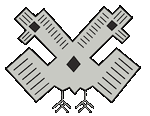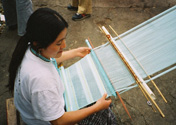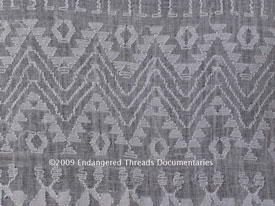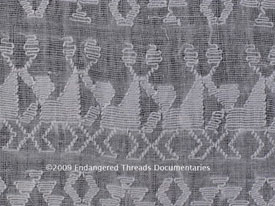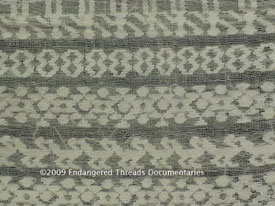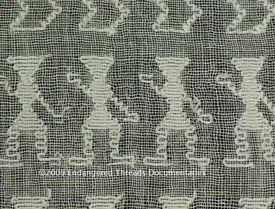Sheer Elegance: Surviving Strands of Ancient Maya Weaving
Narrator: Lina del Roble
Spanish translation on screen
Running time: 73 minutes
View on YouTube
Sheer Elegance focus on a style of fine translucent textiles with brocaded decorations that have been woven by some Maya weavers of Guatemala and southern Mexico since the Classic Maya Era (250-900 CE).
In the opening segment of this documentary, anthropology professor Christina Halperin, PhD, examines examples of such sheer weavings depicted on murals, painted pottery and carved stone from the Classic Maya Era.
Subsequent segments highlight examples from publications and museum collections, as well as present day Maya weavers in Alta Verapaz, Guatemala, and Venustiano Carranza, Chiapas Mexico.
Testimonials and reviews:
“The finished product is a gem. You captured the spirit of the weavers, and the exquisite beauty and variety of the weaving to perfection, while providing landscape/village shots that give the pieces pride of origin. The overall narrative came together nicely, and I love the final shot of that gorgeous little girl, ideally a future weaver. Amazing isn’t it, how much richness and beauty can come from a land that has been so tortured? Your videos have done honor to the gifts that have come to us from Mayan hands.”
Kate Leiva (San Francisco CA)
"(L)ove it. And learned a lot. Good good job."
Deborah Chandler (Guatemala City, Guatemala)
"We are all impressed! We can only imagine how much went into over an hour of final video production. The strong but bittersweet impression for us is that ETD was possibly capturing a craft, a tradition that may not last more than one or two generations going forward due to the influx of Asian materials, which could make the recording that much more precious over time. We think that Sheer Elegance stands as a remarkable achievement. Kudos to ETD and to everyone involved with the production for bringing it to completion. Watching the credits at the end made it seem even more impressive."
Peter Davis, (Cumberland,ME)
"Once again, BRAVO!"
Dai Williams (London, England)
"It is a fine legacy you are creating (and) many people will benefit."
Ashley de Acuña (Cobán Guatemala)
"It is really a stunning, awe-inspiring look at the weaving, the culture and the women. Bravo."
Judith Haden (Santa Fe, NM)
"(G)reat video! Excellent music, used very well in the video. Top notch editing!"
George O. Petty (Berkeley CA)
"(S)o glad you were able to document that work. (T)hanks for the work you put into it and your perseverance in getting it done and available."
Charlene Woodcock (Berkeley CA)
"What a wonderful tribute to the Mayan Weavers. Everything was perfect. Loved the scenic photography, loved the music, loved the voice of the gal who narrated, loved your wonderful descriptive wording."
Dorothy Arata (Napa CA)
"What beautiful cloth and lovely people. How valuable it will be to researchers as well as textile lovers and people with an interest in other cultures. I can also imagine how much the weavers appreciated the attention to their art. ((N)ice music too!)"
Janna Marchione (Reston VA)
"Congratulations again!"
Margarita Sorock (Cartagena, Colombia)
"Your content and video production are superb in every way! For interested viewers like us with little background in weaving, the explanations are both clear and thorough. The scenery is breathtaking!"
Bob & Laura Mossman (Denver CO)
"Peter Davis, Cumberland, John & Eleanor Davis, Yarmouth, MECongratulations on this monumental achievement."
Lina del Roble (Oakland, CA)
"Eleanor and I were extremely impressed… We watched the program with awe. You and all of those working with you are to be complemented. It has been a wonderful project on all fronts. Foremost, the level of professional work in putting it all together as a video presentation is incredible. It is so smooth and the manner in which you tied together the many different weaving approaches and the backgrounds of many dozens ofcommunities is beyond description. On top of all that your understanding of the many weaving techniques and procedures is amazing!
Above all, what comes through so clearly is your commitment to these people. It is wonderful and they are so very fortunate to have had your help and determination to carry through to the end despite your own health problems and innumerable local political problems that I'm sure often defied correction or elimination.
Finally, I must add that we were so impressed with the geological background and your intrinsic interweaving of all aspects into a whole colorful creation. It is wonderful and you are to be very, very proud of your result."
John Davis,(Yarmouth, ME)
Documenting the Maya Textile Tradition:
Recent Work in Venustiano Carranza & Alta Verapaz
AAA Presentation in Adobe PDF
by Kathleen Mossman Vitale
American Anthropological Association 2010 annual meeting.
Note: This large pdf file can take more than a minute to upload and requires some zooming in Adobe Reader, but it will be well worth your while.
AAA Presentation Reference Notes in Adobe PDF
AAA Presentation Update
Subsequent to the AAA presentation, additional field research in Venustiano Carranza, Chiapas, Mexico, including a 2014 trip with Liz Frey (Fine Arts Professor, spinner and weaver) debunked printed and spoken assertions by those selling the translucent textiles in Chiapas that the thread used is hand-spun from raw cotton.
The sheer translucent weave with brocaded designs is actually made from Iris 30/2 ply mercerized commercial thread that has been divided and re-spun by hand before weaving on a back-strap loom. The latter commercial thread source is true whether or not the indigenous weaver tries to demo spinning from bits of old, leftover raw cotton or other fibers. Some ancient tree cotton can be found, but microscopic inspection proves tree cotton is definitely not usable for the sheer textiles. In fact, no usable raw cotton has grown in or been imported into the area around Venustiano Carranza for decades. All the original wild raw cotton plants were destroyed when the sugar cane industry took over the area in the 1980s.
Visuals included in the documentary Sheer Elegance show the entire process now used to divide commercial thread. High quality photos of finished textiles in the documentary show the sheen from the mercerization process on the divided commercial thread in finished textiles. Soft raw cotton does not reflect lights, even after it is washed.
In giving credit where credit is due, the split commercial thread solution for translucent textiles is an ingenious one devised by indigenous weavers who have done and will do anything to survive. The translucent weavings of today are never worn by the local indigenous people because they are way too expensive. The only question is: Who makes money off the false claims that today’s sheer textiles are made of hand-spun raw cotton? The weavers? Or those who control the published word and the marketing to collectors and museums?
Short Video on Translucent Weaving in Alta Verapaz, Guatemala
Translucent weaving with small brocaded designs is called Pikb’il by Q'eqchi'-speaking Maya weavers in Alta Verapaz, Guatemala. This short video was made in the early 2000s, and used as a loop at the University of Pennsylvania Museum of Archeology & Anthropology’s exhibition Painted Metaphors: Pottery & Politics of the Ancient Maya.
Pikb’il is an ancient Maya style of using fine white cotton thread in a balanced, spaced weave, with supplementary weft brocade designs. |
||
Pikb'il design of arches (arcos SP) made by supplementary weft brocade on a spaced weave textile on a backstrap loom. Photo by Kathleen Mossman Vitale. © 2009 Endangered Threads Documentaries. |
Pikb'il design of women or female dolls (muñecos SP) made by supplementary weft brocade on a spaced weave textile on a backstrap loom. Photo by Kathleen Mossman Vitale. © 2009 Endangered Threads Documentaries. |
|
Pikb'il design of deer made by supplementary weft brocade on a spaced weave textile on a backstrap loom. Photo by Kathleen Mossman Vitale. © 2009 Endangered Threads Documentaries. |
Pikb'il design rows of dolls (muñecos SP), figure eights, stars & planets, and domestic fowl. The designs are made by supplementary weft brocade on a spaced weave textile on a backstrap loom. Rachael Gould Mossman Collection. Photo by Kathleen Mossman Vitale. © 2009 Endangered Threads Documentaries. |
|
|
||
 ETD intern Callie Vandewiele learned Pikb'il-style weaving on a backstrap loom while living in Alta Verapaz, Guatemala, 2008-9. Photo by Terra Leigh Vandewiele. © 2009 Endangered Threads Documentaries. |
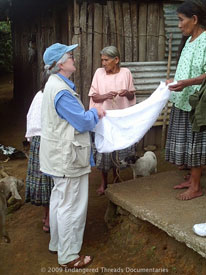 ETD co-founder and videographer Kathleen Mossman Vitale discusses weaving techniques with weavers in Alta Verapaz, Guatemala. Photo by Ned & Marilynn Vilas. |
|
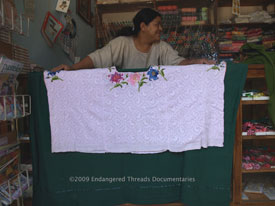 Pikb'il huipiles or blouses with added embroidery around the neck are occasionally sold in weaving supply stores in Alta Verapaz, Guatemala. Photo by Callie Vandewiele. © 2009 Endangered Threads Documentaries. |
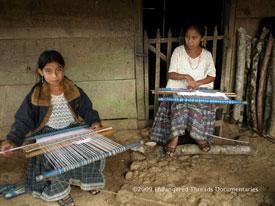 Young Q'eqchi'-speaking Maya girls learn Pikb'il weaving at home in Alta Verapaz. Photo by Callie Vandewiele. © 2009 Endangered Threads Documentaries. |
|
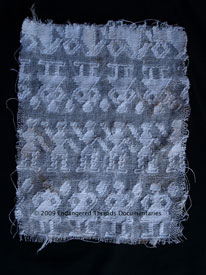 Fragment of a textile used to teach Pikb'il weaving to young girls in a Q'eqchi' family in Alta Verapaz. Photo by Callie Vandewiele. © 2009 Endangered Threads Documentaries. |
 Pikb'il weaver Concepción Poou Coy de Tharin wears her wedding huipil or blouse and shows off an uncut Pikb'il huipil from Alta Verapaz. Photo by Jonathan Theran |
|
